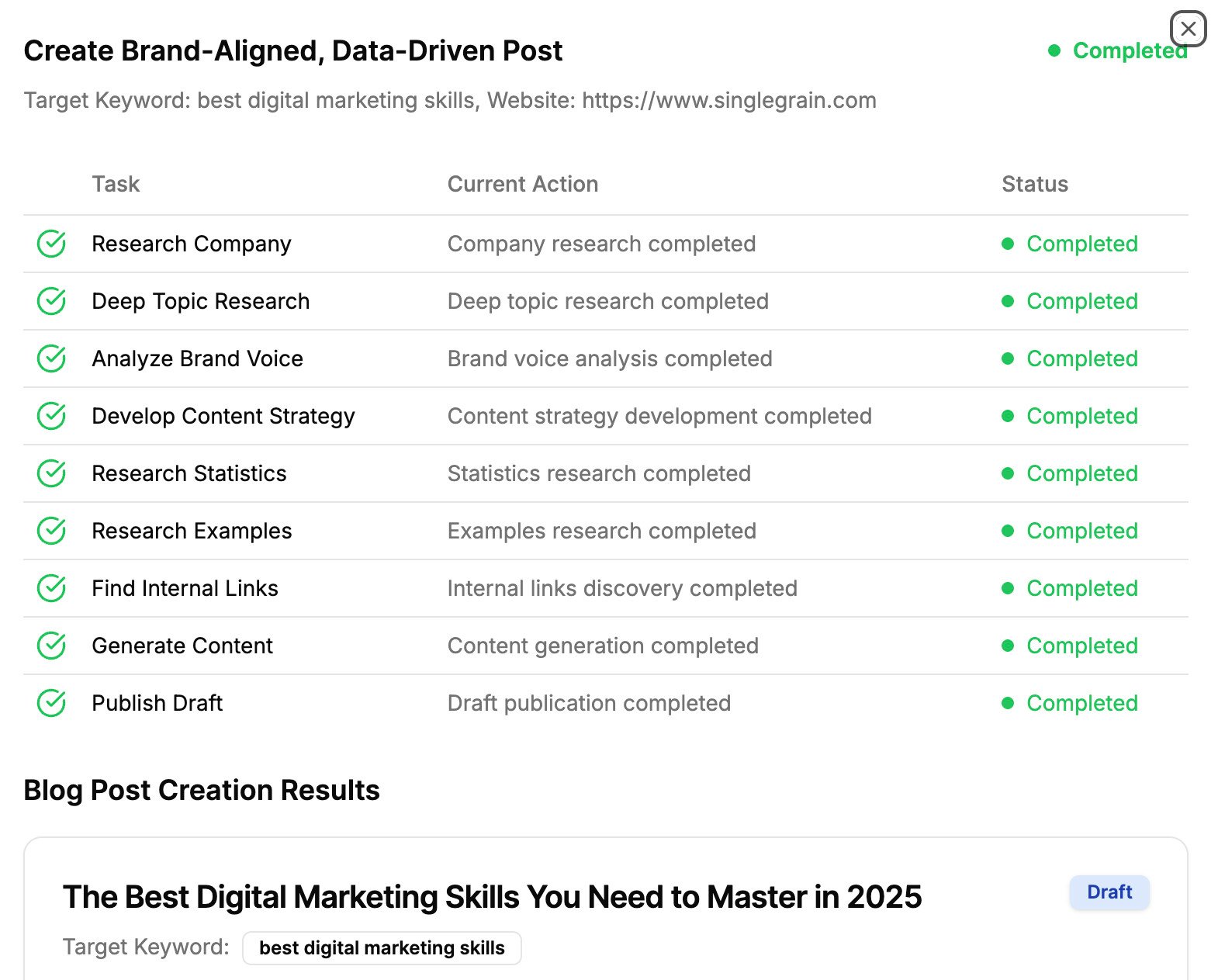Curious about account-based marketing process? This article will walk you through exactly what it encompasses.
Many businesses notice that generic marketing strategies often fail to achieve KPIs. This is especially true in B2B marketing, which targets key decision-makers.
ABM (also called signal-based selling) targets specific accounts and fosters personal relationships, resulting in long-term growth and sales potential.
But what is account-based marketing? Why should your business invest in this strategy?
Let’s take a look.
Key Takeaways
- Account-based marketing is a strategy that targets high-value accounts with personalized outreach and tailored messaging.
- ABM offers many benefits, such as a higher ROI, personalized engagement, aligned marketing and sales teams, better customer retention, and a shorter sales cycle.
- An account-based marketing strategy requires an ideal customer profile (ICP), a sales funnel tailored to ABM, personalized content, multichannel engagement, sales and marketing alignment, and KPIs.
- To implement ABM, identify your target accounts and craft personalized messaging for each segment. Leverage technology like CRMs and marketing automation platforms. Use various channels to engage your accounts. Monitor your results and refine your plan when needed.
- As account based marketing goals evolve, the associated tactics and technologies are expected to improve, specifically with account identification and marketing personalization.
TABLE OF CONTENTS:
What Is Account-Based Marketing?
Account-based marketing (ABM) is a strategy that engages individual accounts (or companies). Marketers achieve this by using tactics such as personalization and tailored messaging.
Traditional marketing tactics, such as advertising, aim to attract a broad audience. Instead, ABM zeroes in on a specific set of high-value businesses more likely to convert. This is why companies that use ABM see a 208% increase in revenue.
Sales and marketing alignment is the secret to ABM’s success. These teams work together on lead generation efforts, identifying target accounts, understanding their pain points, and creating personalized campaigns that resonate deeply with decision-makers. This is why 76% of marketers say they get a higher ROI with ABM than other marketing strategies.
Three Types of ABM
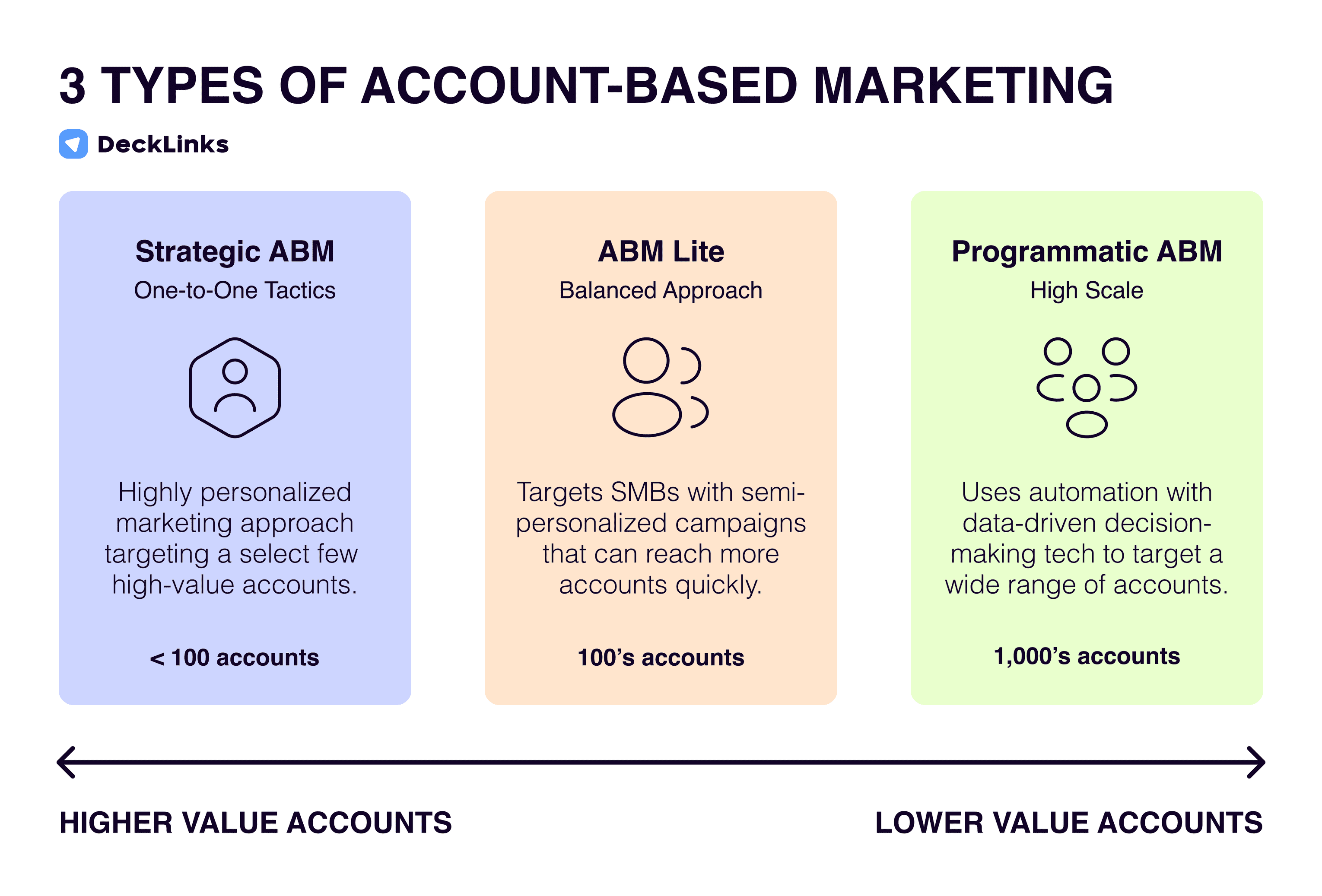
Source: Decklinks
Signal-based selling has three primary types: strategic ABM, ABM lite, and programmatic ABM. Here’s how they differ:
- Strategic ABM (one-to-one): These campaigns target a small number of high-value accounts. This approach involves deep research and collaboration between marketing and sales teams to create tailored strategies for individual accounts. The result is a deeper relationship with each account.
- ABM lite (one-to-few): Focuses on small clusters of accounts with similar characteristics, such as industry or business challenges. This approach balances personalization with scalability.
- Programmatic ABM (one-to-many): Tailored to a broader set of accounts. It emphasizes automation and data analytics for efficient targeting at scale.
Benefits of Account-Based Marketing
Account-based marketing is not just another buzzword; it is a game-changer for businesses seeking meaningful growth and building strong relationships with high-value clients. Here are some reasons why ABM is worth the investment.
Higher ROI
We’ve already said that ABM results in a better ROI compared to other marketing tactics, but why is that?
You’re focusing marketing resources on accounts with the highest revenue potential. This is more effective compared to traditional, broad-based marketing strategies. Plus, marketers also save more money by only investing in the resources they need.
Personalized Engagement
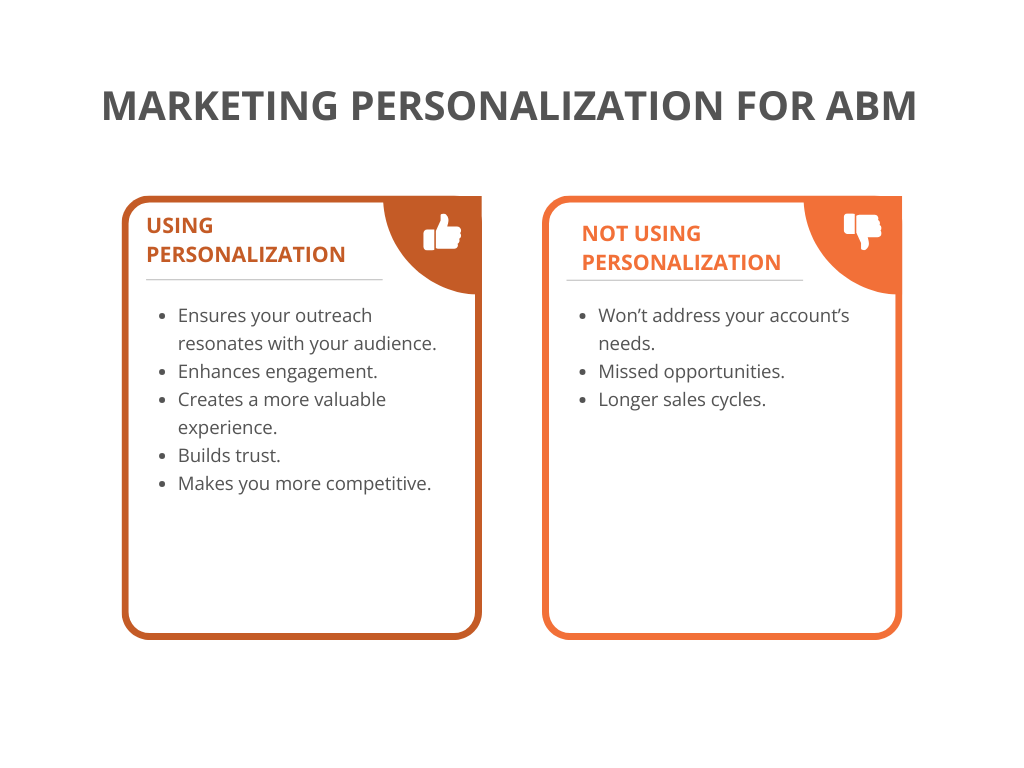
ABM’s emphasis on personalized content and messaging ensures your outreach resonates with target accounts’ specific needs and challenges. Personalized messaging enhances engagement, creates a more valuable experience, and builds trust. This makes it more likely for prospects to consider your solutions over a competitor.
Collaboration Between Marketing and Sales Teams
When sales and marketing teams align, companies can experience 36% higher retention rates. Cross-team collaboration results in better communication and shared goals, ensuring that both teams are on the same page. Plus, this alignment results in other benefits, such as a more streamlined approach and a better chance of sticking to a budget.
On the contrary, misalignment between sales and marketing teams can lead to inefficiencies and missed opportunities.
Improved Customer Retention
Companies that use ABM report an 80% improvement in customer relationships. That’s because ABM is not just about acquiring new clients but also about deepening relationships with existing ones. ABM strategies achieve this by delivering value and demonstrating a deep understanding of your client’s needs. As a result, ABM strengthens loyalty and encourages long-term partnerships.
Shorter Sales Cycles
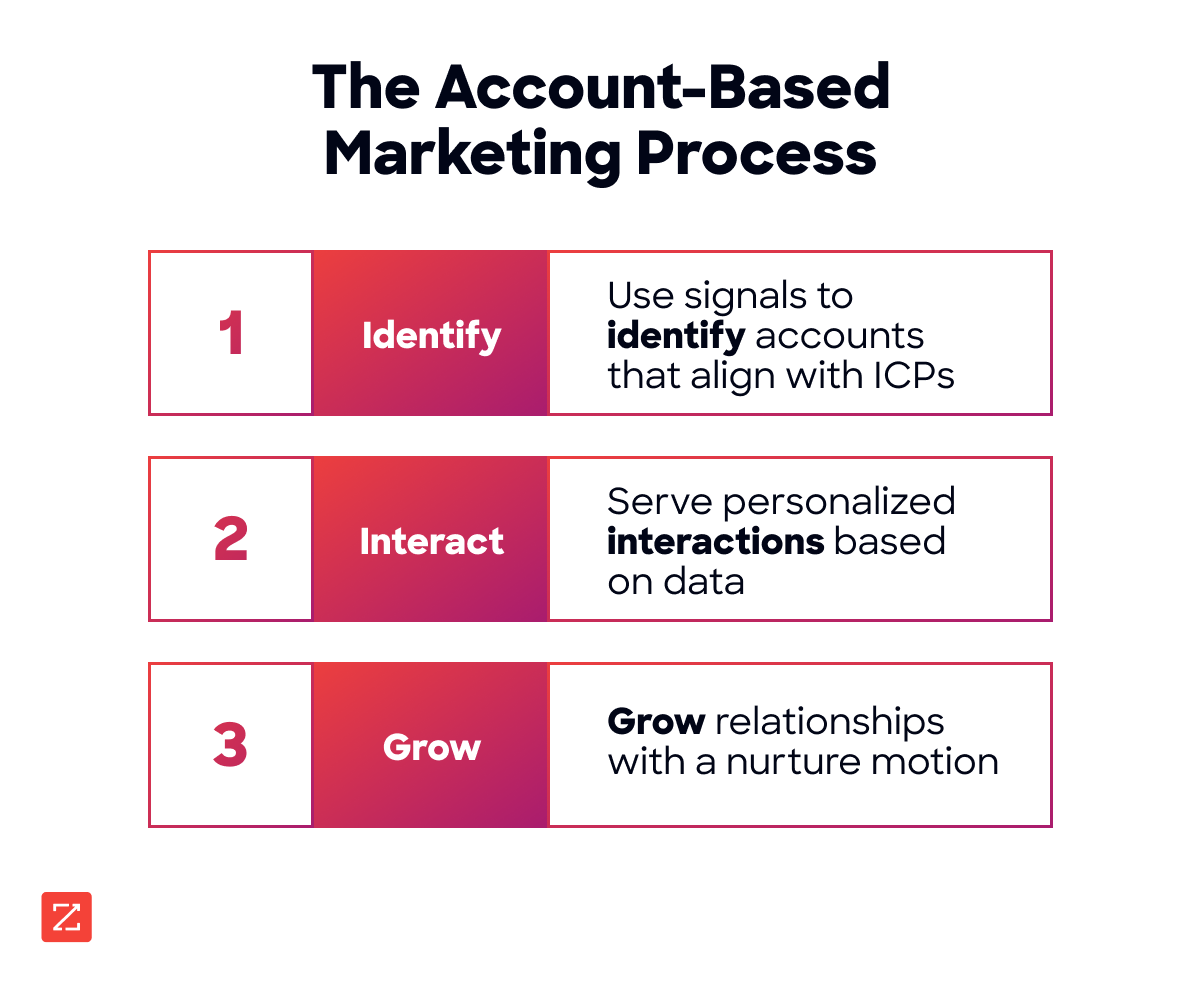
Source: pipeline.zoominfo.com
ABM marketers target high-quality accounts and drive interest immediately during the customer journey. This saves time and resources and results in a shorter sales cycle.
In B2B sales, lengthy decision-making processes can delay conversions. ABM helps shorten sales cycles by addressing concerns, offering personalized outreach, and presenting tailored solutions. This makes the sales cycle more efficient, and your leads will convert more quickly.
The Key Components of ABM
The ABM sales funnel differs from traditional pipelines because the first step is to target accounts rather than focus on awareness. Because of this, your ABM strategy must have specific components to ensure your campaign is effective.
Ideal Customer Profiles
The foundation of ABM lies in identifying the best accounts to target. But what is a high-value account? Identifying the best accounts will take research and knowing the qualities that make an account more likely to convert. These qualities usually include firmographics, such as company revenue and the industry they’re in.
Once you have this data, the sales and marketing teams can create an ideal customer profile (ICP). These teams can prioritize their marketing efforts on these accounts and nurture them to become devoted customers.
ABM Sales Funnel
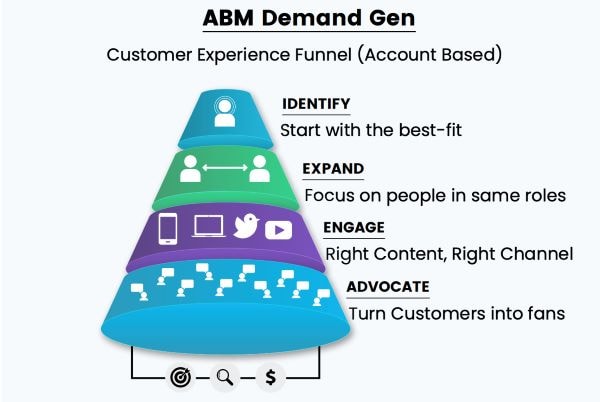
Source: Digital Marketing Consulting
Compared to other marketing strategies, ABM has a different customer journey that accounts go through. The ABM sales funnel visualizes this journey, and each stage represents the unique decision-making journey and more specific actions compared to traditional pipelines.
After creating ICPs, marketers target those specific accounts with personalized outreach and marketing to generate interest from the lead. This differs from traditional pipelines, which start with brand awareness, and the lead doesn’t develop interest in the brand until the second stage.
As the account generates interest, sales teams must nurture relationships with these accounts and promote your brand as a solution to their problems. After the account becomes a customer, the process doesn’t end. The final stage is retainment, which aims to foster long-term relationships with accounts.
Personalized Content
How can you empathize with a company’s pain points and offer your product as a solution? Content is and has always been king for a reason. Valuable content educates customers and helps them solve their most significant issues. That’s why once you identify your target accounts, the next step is crafting customized content and messaging tailored to each account’s specific needs, challenges, and goals.
Content marketing differs from ABM since personalization is integral to your strategy. 76% of customers say they’re more likely to purchase from brands that use personalization. Personalized content resonates better with accounts and better targets key decision-makers.
Marketers can personalize different forms of content, such as:
- Social media marketing
- Emails
- Blogs
- Whitepapers
- Videos
- Webinars
- Programmatic advertising
Multichannel Engagement
Engaging your accounts doesn’t end with content. ABM leverages multiple channels—email, social media, events, and direct mail—to reach decision-makers where they are most active. All ABM marketers must adopt a multichannel approach combining sales and marketing channels.
This is where sales and marketing alignment comes in. Sales professionals can set up meetings, cold calls, and book demos to build relationships with accounts.
Marketers can create different types of personalized content and repurpose them for other channels. Inbound marketing tactics are also effective for ABM; while inbound marketing focuses on a broad reach, both strategies use similar outlets, such as email newsletters and LinkedIn posts, to target leads. Other channels ABM marketers can use include industry publications, blogs, and paid ads.
Side Note: There’s a really handy tool for building ABM ads for LinkedIn at scale, based on your ideal target account specifications. It’s called Karrot.ai and you can join the waitlist here.
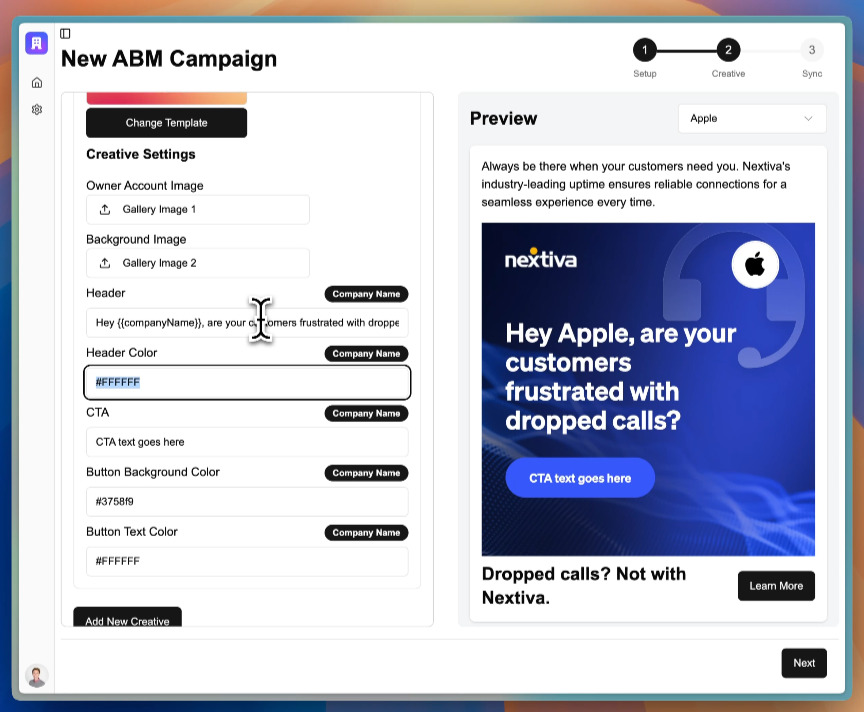
Alignment of Sales and Marketing
Aligning sales and marketing teams has come up quite a bit in this post. But what does it mean, and why is it integral for ABM?
Sales and marketing alignment ensures that accounts have a comprehensive buying experience. In other words, the account is engaged through every sales funnel stage. To achieve this, sales and marketing teams must be on the same page and execute these strategies together. Both must share data and insights to ensure a cohesive and impactful approach.
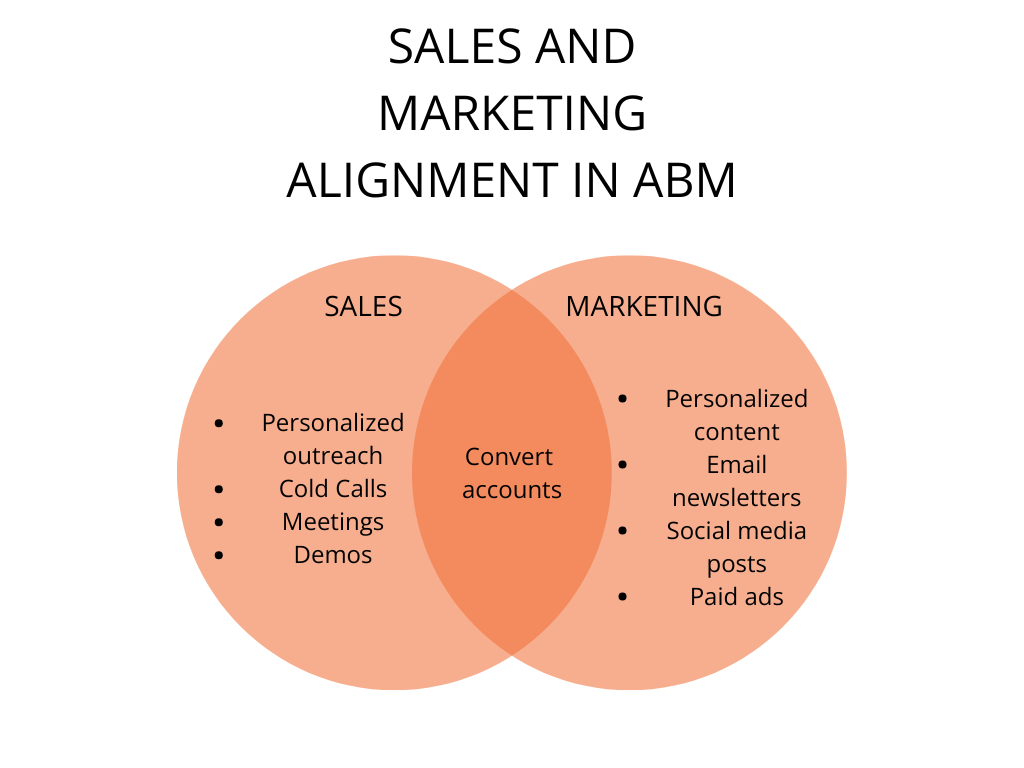
Analytics and KPIs
Tracking the success of ABM campaigns is essential. If you’re not measuring your ABM results, you’ll never know what’s working in your campaign. Plus, you risk wasting marketing dollars on ineffective tactics.
First, identify the KPIs to track based on your goals. Metrics such as engagement rates, pipeline growth, ROI, and account-specific revenue help determine your strategy’s success and ensure you profit from ABM.
Brands that are new to ABM may want to track specific metrics, such as brand awareness, customer lifecycle, and lead quality, to test their customer profiles and measure their profitability.
How to Implement ABM in Your Business
Now that you know about ABM, it’s time to create your strategy. Adopting ABM requires careful planning and execution. Here is a step-by-step guide to help you get started.
Identify Your Target Accounts
Identifying your target accounts will take some research. Use data analytics and insights to identify high-value accounts that align with your business objectives.
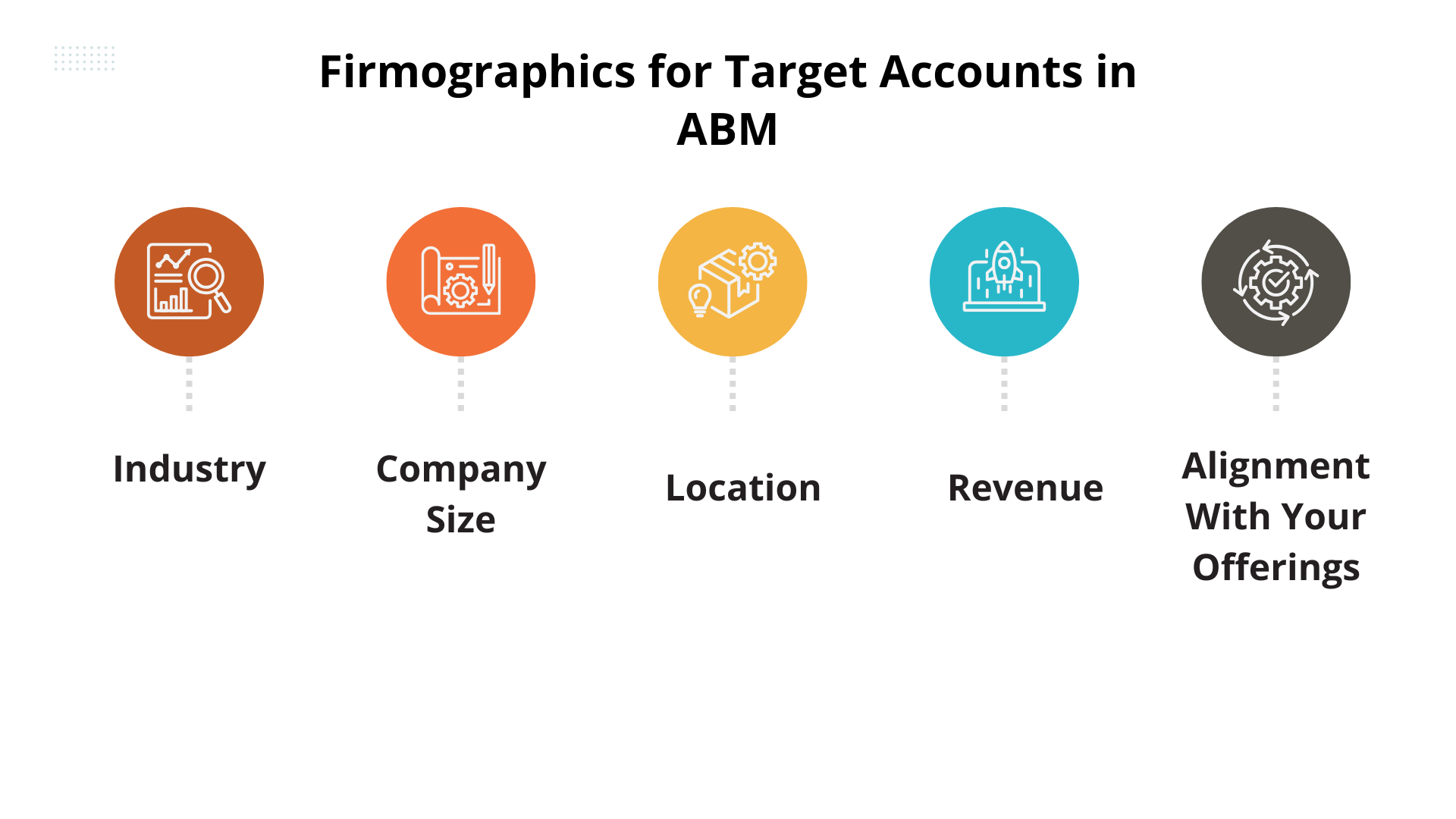
Consider industry, company size, location, revenue potential, and alignment with your offerings. You can also find the qualities of leads you converted in the past, business objectives you’re targeting, spending patterns, growth trajectory, and the tools they may be using (or aren’t using if you’re a SaaS business).
Once you have this information, create an ICP or customer persona based on your target role. For example, if you’re selling a digital marketing tool, you will likely create an ICP for the Digital Marketing Director or Digital Marketing Manager. If you’re unsure which role to target, go to LinkedIn, find the accounts you commonly connect with, and see if they have similar roles.
Develop a Custom Strategy for Each Account
ABM marketers must deliver a personalized message to each prospect to drive interest. Tailored marketing and sales strategies address each account’s unique needs and preferences. But this can be challenging if you’re targeting various accounts.
Start by segmenting your accounts based on target markets. This can be based on similarities between the accounts, such as targeting the same roles or segmenting based on their sales funnel stage.
Leverage Technology
Account-based marketing requires a lot of collaboration and data collection. ABM tools and platforms can streamline these efforts.
Technologies like CRM systems, marketing automation, and analytics platforms can help you effectively manage and measure your campaigns. Don’t forget niche tools like marketing personalization software. Popular examples of ABM software include Demandbase and 6sense.
Execute Multichannel Campaigns
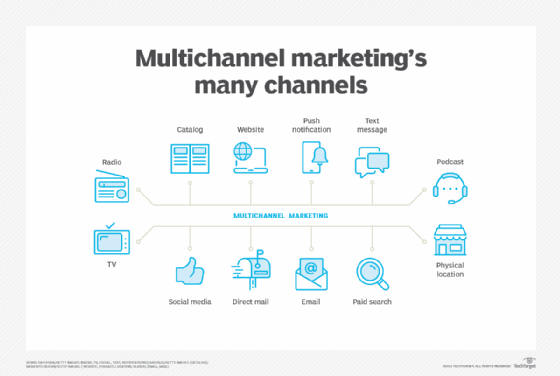
Source: TechTarget
Reach out to your target accounts through multiple channels to maximize engagement. Craft your messaging to be tailored to each account and consistent across all platforms.
Numerous channels are effective for ABM, such as events, email, ads, and direct mail. While ABM requires a multichannel strategy, knowing which channels to prioritize can be challenging. Use the platforms that make sense for your accounts and where you can foster a deep relationship with them.
Monitor and Optimize
While all marketers must regularly measure the performance of ABM campaigns, the best KPIs differ from those used in other types of marketing. Since ABM requires marketing and sales efforts, marketers should focus more on revenue growth and pipeline success. Measure metrics like engagement rates, lead quality, and revenue growth to evaluate success and make necessary adjustments.
ABM also requires tracking other successes. This includes opportunities created, account value, and closed-won deals.
The Future of ABM
ABM trends show this strategy will evolve in two ways: better account identification and more marketing personalization opportunities.
This is where AI and automation come into play. Innovations in technology like predictive analytics and personalization tools (like Karrot) are expected to enhance the effectiveness of ABM strategies.
Deep learning AI and machine learning can launch and execute an ABM strategy faster and more effectively.
Specific tools, such as CRMs, are constantly improving to analyze data better, identify new accounts, and offer better insights to keep accounts engaged. Since ABM is becoming a more popular strategy, new tools are continually emerging that offer innovative functions like lead scoring and insights on account attributes.
There are some hindrances to ABM. Marketers and ABM technology must adhere to various privacy laws. Fortunately, most CRMs and other data collection tools offer encryption, secure servers, and access controls to stay compliant. It’s still a good practice to only collect data necessary for your campaign and refrain from collecting sensitive data.
Another Account-Based Marketing Option
If traditional marketing tactics aren’t generating results, you may benefit from account-based marketing. But what is account-based marketing? This strategy aims to target and engage individual accounts and convert them into long-term customers.
Account-based marketing stands out because it prioritizes quality over quantity. It focuses on high-value accounts to deliver personalized experiences, which will help businesses achieve sustainable growth and build lasting client partnerships. Whether you are a small business or a large enterprise, ABM can improve ROI, increase revenue, and make you more competitive.
While ABM offers a lot of promise, this strategy requires a lot of effort. Brands must align sales and marketing to personalize outreach and engage accounts on multiple channels. If your organization doesn’t have these resources, an ABM agency is another option.
If you’re ready to level up your account-based marketing strategy, Single Grain’s ABM experts can help!👇
Frequently Asked Questions about Account-Based Marketing
-
Is ABM right for my brand?
ABM can be an excellent fit if your business aligns with specific criteria. Here are some key considerations to help determine if it’s the right approach for you:
- High-value leads are critical to your sales.
- You have complex products, services, or sales deals.
- Are already using marketing personalization tools.
-
Is ABM expensive?
he cost of ABM depends on how much you use this strategy, the size and expertise of your team, and the technology you use. Before investing in ABM, plan a budget and ensure your investments make sense for your ROI.
-
What's the difference between ABM and customer marketing?
ABM and customer marketing have different focuses in the sales pipeline. While customer marketing aims to deepen relationships with consumers, this strategy focuses more on retaining existing buyers while ABM drives new and existing accounts down the sales funnel.
They use similar techniques, though customer marketing focuses more on loyalty programs and buyer-centered communities. As a result, customer marketing usually tracks metrics such as retention rate, net promoter score (NPS), and upsell/cross-sell revenue.
-
What are some unique account-based marketing strategies?
Many innovative ABM tactics can enhance your strategy. Examples include personalized micro-websites and landing pages, branded kits, personalized gifts, influencer marketing, case studies, gamification like quizzes, customized event invitations, and VIP dinners.
-
How long does it take to see results from ABM?
The time it takes to convert an account depends on your sales cycle and ABM strategy. If you already have an ICP and strong connections with potential leads, you can convert them in a few months. However, if you have a longer sales cycle, ABM may take as long as a year.
Related Video
For more insights and lessons about marketing, check out our Marketing School podcast on YouTube.






